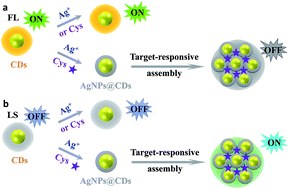Dual-modal fluorescence and light-scattering sensor based on water-soluble carbon dots for silver ions detection†
Abstract
A facile fluorometric and light-scattering dual-modal nanosensor for silver(I) ions detection was established based on target-responsive aggregation of carbon dots/cysteine system. The synthesized water-soluble fluorescent carbon dots (CDs) by the one-pot hydrothermal method exhibited emissions peak at 441 nm under excitation at 352 nm. CDs fluorescence was quenched by Ag+via electron transfer, while the light-scattering intensity of CDs was significantly enhanced, providing a dual-modal means of analyte Ag+ detection. The relative fluorescence intensity is directly proportional to the concentration of Ag+ between 0.1 μM and 265 μM, and the detection limit is 50 nM. Moreover, the relative light-scattering intensity is proportional to the concentration of Ag+ from 10 to 4000 nM with the detection limit 2 nM. Common compounds including different types of metal ions had no significant interference in the detection mode. The new nanosensor was simple, rapid and sensitive and was applied to the detection of Ag+ in real water samples with satisfactory results. Moreover, the present CDs-based dual-modal sensor provided a promising platform for environmental sensing applications.



 Please wait while we load your content...
Please wait while we load your content...